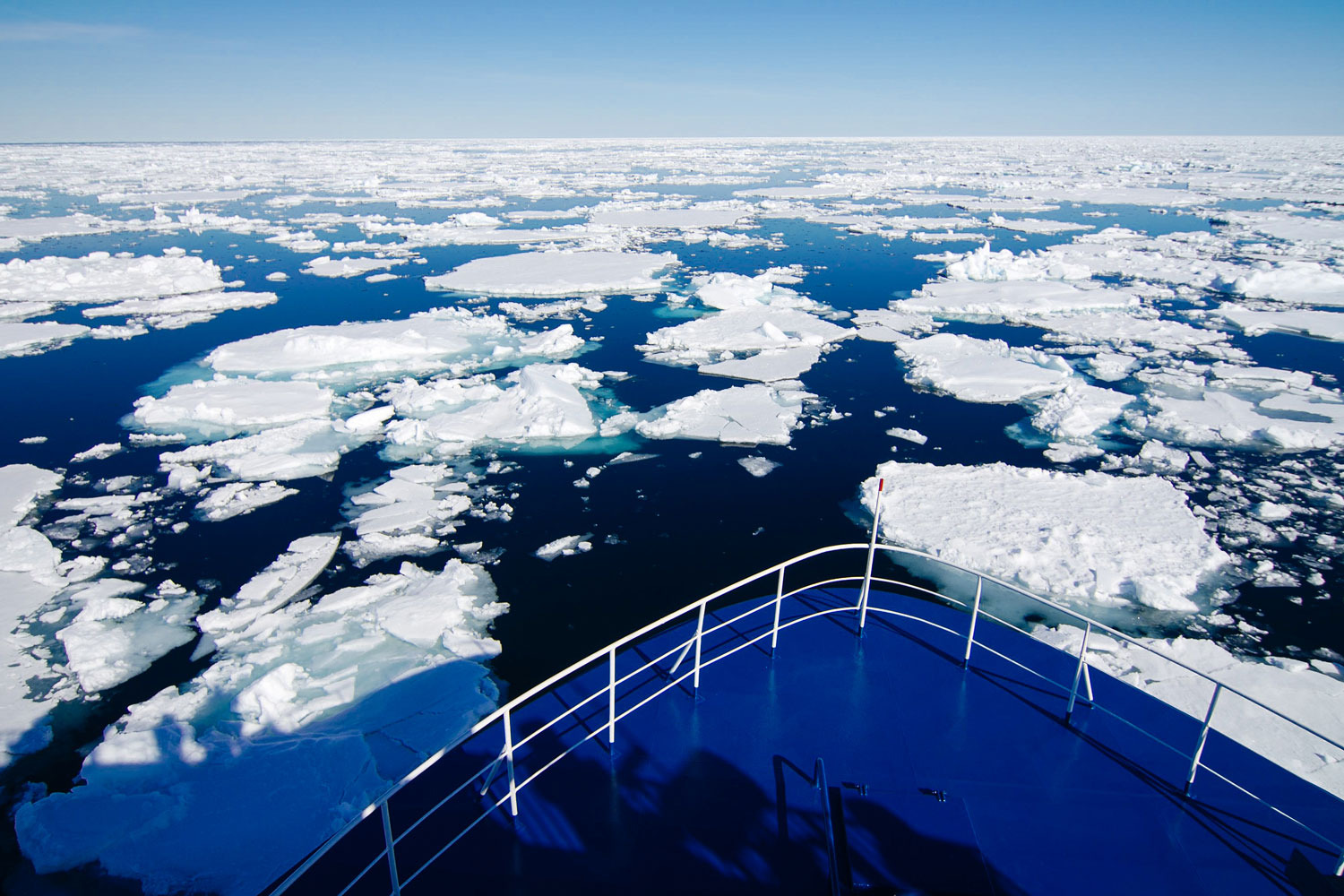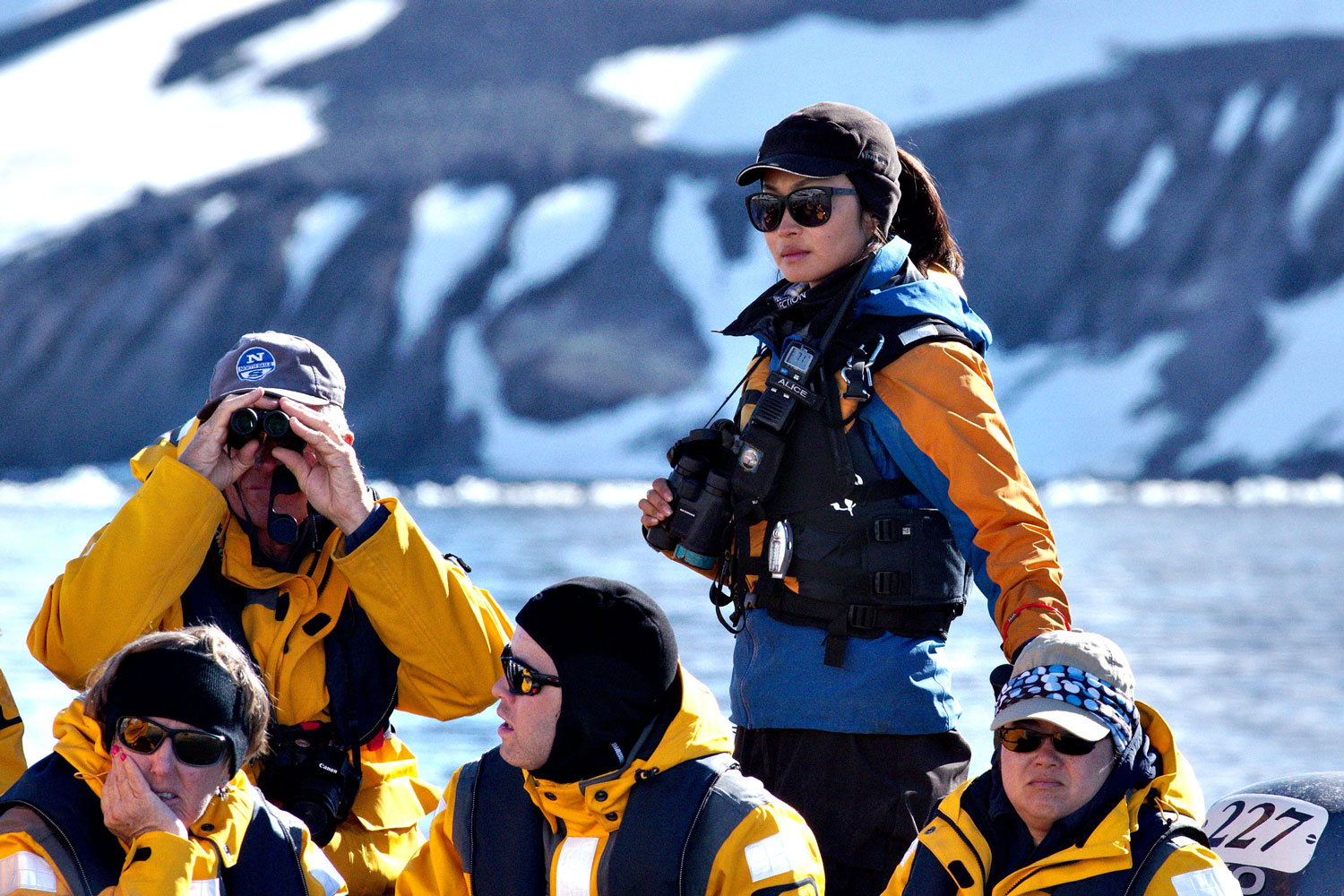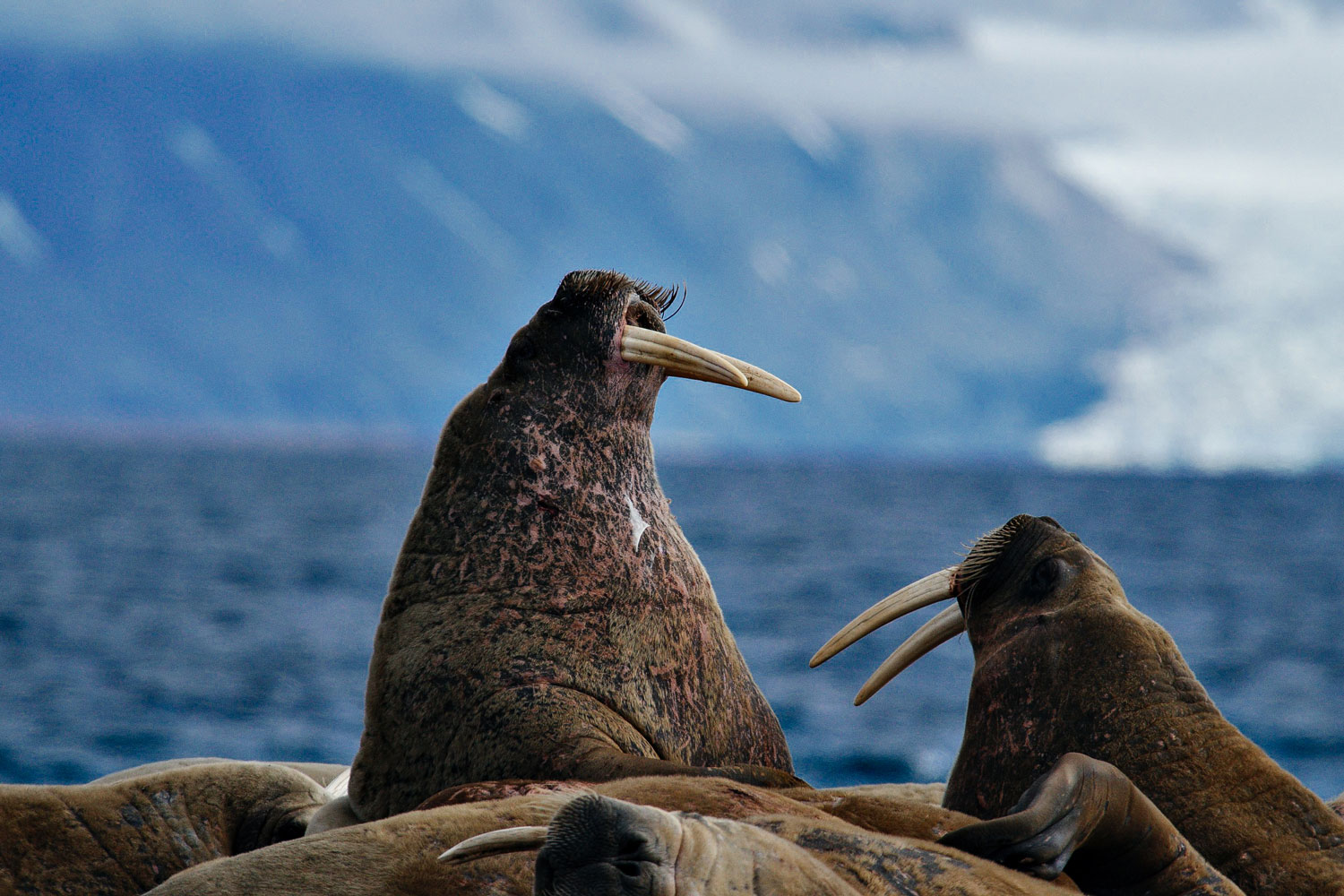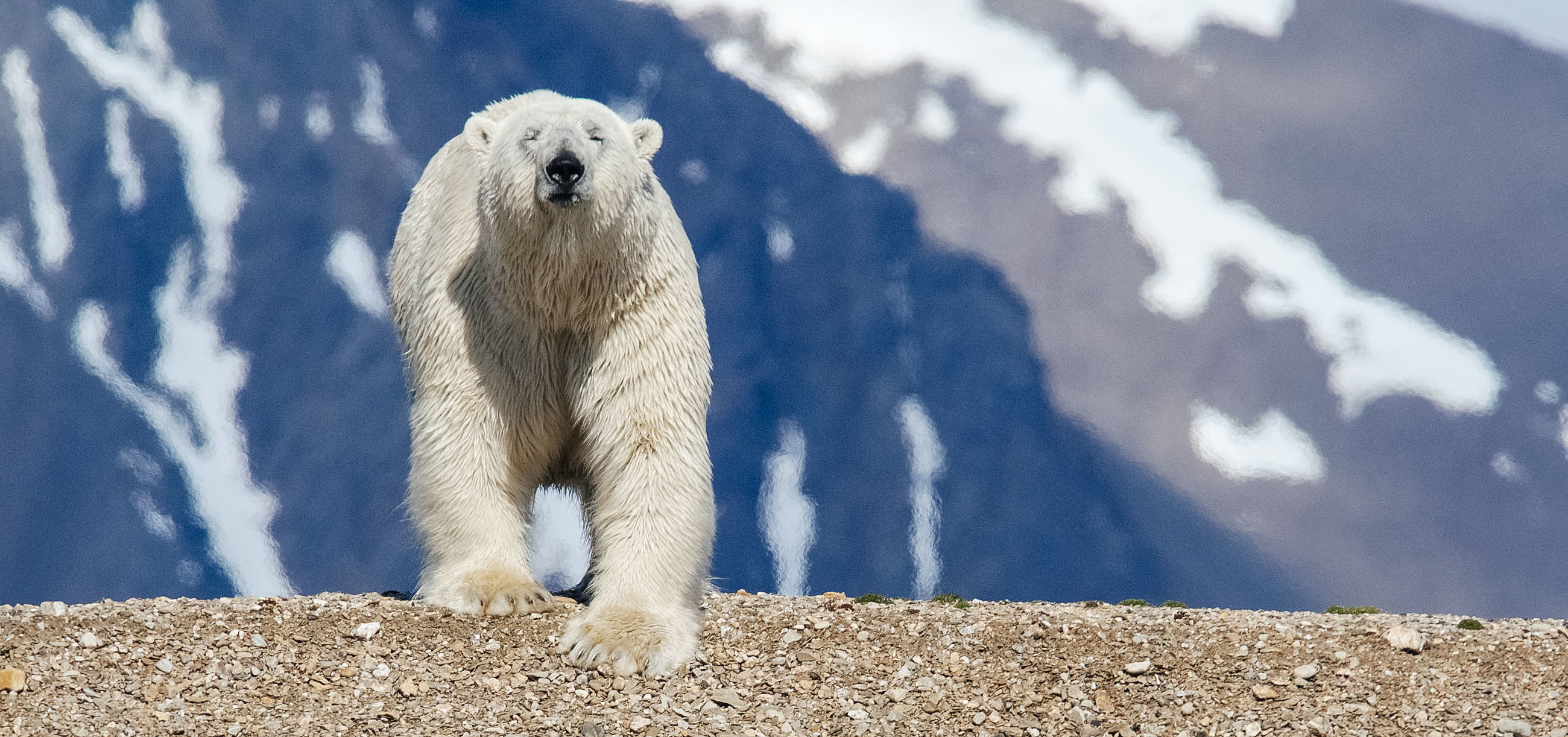From three decks up, the sea ice surrounding our ship looks like so many Styrofoam picnic plates bobbing on a dark blue pool.
Some plates are big enough to contain a suburban house and yard; others have barely enough space to park a bicycle. Many are almost perfectly round from jostling against their neighbors in the wind. Tiny tracks crossing one plate look birdlike from my perch, until I check them out with binoculars and realize that this is the trail of a polar bear.
I’m standing aboard the Ocean Nova, a converted ocean-going ferry that’s home to me and 60 other passengers for 11 days while we explore the coast of Svalbard, one of the most remote — and northerly — places in the world.
Svalbard lies due north of Tromsø, Norway. At the archipelago’s far-northern end, where we’re exploring the sea ice in hopes of spotting a polar bear, we’re less than 700 miles from the North Pole. The Nova noses slowly but steadily along the rocky coast, its reinforced steel hull reverberating like a gong as it pounds the pack ice.
It was from this barren collection of islands that hopeful adventurers set off a century ago — sometimes never to return — to be first to reach the North Pole. In that golden age of exploration, Norwegian explorer Roald Amundsen, who in 1911 had become the first human to reach the South Pole, disappeared in a plane in 1928 while searching for six members of an Italian expedition that had headed north from Svalbard in a dirigible.
Enlarge

Photo by Bob Keefer
In 1893 Norwegian Fritjof Nansen allowed his ship, the Fram, to freeze into the ice pack north of Siberia. Drifting, according to his radical plan, in a northwestern arc, it wound up nearly three years later — both ship and crew intact — near Svalbard, propelled by currents in the ice. Add in some tough overland sledding and Nansen came within 350 miles of the pole.
Today Svalbard is populated by a different kind of adventurer — high-end tourists.
Driven by baby-boomer bucket lists, cheap airfare and an urgency engendered by climate change, polar tourism — almost unheard of half a century ago — has grown immensely in the past decade. Virtually unvisited in the recent past, Svalbard now gets more than 40,000 cruise ship visitors a year.
You once had to organize your own expedition to see places like this. Now you can buy a ticket, assuming you have the $10,000 per person it takes to book a cabin on this cruise. (Our trip was heavily discounted because our son, Noah Strycker, works on the ship as an onboard bird guide for Quark Expeditions.)
Champagne flowed on the Nova the afternoon we crossed 80 degrees of latitude — 690 miles from the North Pole. That evening, when we reached 80 degrees, 12 minutes and 3 seconds north of the equator, John Rodsted, the trip leader, decided the sea ice was too tight to keep grinding our way north and turned us south again.
We were nearly two full days in the ice and hadn’t seen a single polar bear.
Enlarge

Photo by Bob Keefer
Getting to Svalbard usually means flying to the tiny town of Longyearbyen, where our jet from Oslo touched down just past midnight on a bright, drizzly June night — all of Svalbard is above the Arctic Circle, meaning 24-hour summer daylight. The Longyearbyen airport is better appointed than Eugene’s; you can actually buy a sandwich and a latte there at 1 am. A taxidermied polar bear stands guard over the baggage carousel, the first of several such bears we would see in town, all with signs reading “Do Not Touch!” in English and Norwegian.
Inside the bustling Fruene Kaffe & Vinbar in a shopping mall downtown the next day I joined Mark Sabbatini, editor of icepeople, which advertises itself as the most northerly alt-weekly (circulation 500) on the planet. He reads Eugene Weekly online each Saturday, he says. A journalistic roustabout — he’s worked at the Los Angeles Times and the Juneau Empire and once ran a newsletter at Antarctica’s McMurdo Station — Sabbatini has lived on Svalbard for nearly nine years.
He handed me his most recent issue, a photocopied 16-page newsletter. Its top story was about the town’s new library; headlines inside include “Employment in Longyearbyen drops 12 percent” and “Polar bears shift from seals to bird eggs as Arctic ice melts.”
Like everyone here, Sabbatini is from elsewhere. No evidence has ever been found of indigenous people on Svalbard, whose islands constitute a 24,000-square mile outcropping of barren rock, windswept tundra and glacial ice populated today by roughly as many polar bears as people (about 3,000 in each case). The current human population comes mostly from Norway and Russia with a large Thai community thrown in.
Svalbard, a Norwegian territory, exists in a legal loophole: If you get there and can make a living, you don’t need papers to stay, Sabbatini says. The islanders don’t even pay taxes to Norway.
That might sound like a libertarian paradise, but only up to a point. Get pregnant and you’ll be flown elsewhere (usually Tromsø) to have your baby. This is explained in terms of Tromsø’s better medical facilities but also reflects Norway’s reluctance to create a class of people with birthright citizenship claims in a place that has no citizens.
Internet lore holds that it’s illegal to die in Svalbard. That’s an exaggeration, though you’ll also be sent away when you’re old or ready to pass on. Svalbard has no nursing homes. The only graves are historic sites — about 1,000 whalers, trappers and explorers, by one count, before burials were halted in the 1950s. Permafrost makes digging difficult and tends to push bodies out of the ground.
As our ship makes its way along Svalbard’s spectacular west coast, we nose into narrow fjords, one after another, that terminate in ever-more-spectacular glaciers. The only way to get off the ship is aboard its fleet of rubber Zodiac rafts, and we quickly settle into a routine of daily cruises — usually past the front of a glacier — and wet landings on gravel beaches, from which we can explore abandoned mining settlements, check out enormous bird colonies of kitiwakes, guillemots and puffins nesting on cliff faces, or simply hike straight up the nearest ridge to stand on a local peak.
On a shore excursion one afternoon, our trip leader John Rodsted stops our small group of hikers at a weathered wooden cross that toppled years ago onto the spongy tundra; next to the cross, among stones placed on the grave, you can just see part of a human thighbone sticking out. The owner’s name has long since weathered away from the cross. A trio of short, plump Svalbard reindeer watches from 50 feet away with the dull indifference of cows. Reindeer, reindeer antlers, reindeer poop and clumps of white reindeer fur are everywhere we walk.
After becoming bored with a commercial photography business he ran in Australia, Rodsted headed for Bosnia in 1986 and became a freelance conflict photographer. He and his Norwegian wife, Mette Eliseussen, whom he met while they were both working in Kabul, now guide polar tourists here and in Antarctica on adventure cruise ships like the Nova.
As our group strolls up a rocky path toward a glacial moraine, Rodsted keeps us walking by telling endless entertaining stories of arctic exploration, always promising a new installment at the next stop. He carries a bolt-action rifle slung over his shoulder and a flare gun in a holster on his hip. On Svalbard you’re not allowed to venture outside settlements like Longyearbyen without serious polar bear deterrent. Most people take rifles, and the Nova maintains a small onboard armory.
One morning after breakfast Rodsted announces on the ship’s address system that we are going ashore to see walruses — lots of walruses. We take to the boats as usual and land on a windy beach, where the 60 of us walk in silent single file for a quarter mile along the water’s edge toward a distant noisy brown blob, our rifle-toting guides spread out alongside us. For a moment I feel like we’re prisoners of war being marched to camp in a World War II movie.
Enlarge

Photo by Bob Keefer
When we finally get within a long stone’s throw of the blob, we can hear — and smell! — about 40 walruses, all lying in the sun more or less on top of one another, burping and farting and grumbling and occasionally laying into each other with their ivory tusks, sometimes drawing blood. We fan out and spend 45 minutes looking at, listening to and photographing the compelling spectacle before returning to the ship for lunch.
Finally we see bears. A planned afternoon beach landing suddenly becomes a Zodiac cruise instead when a guide making a safety check from the ship spots a mother and two cubs ambling along the gravel beach near our planned landing site. Moments later another guide spots an enormous male following them half a mile behind.
That begins an extraordinary hour-long bear encounter, with the Zodiacs carrying us just offshore from the bears, who seem unafraid of and even mildly fascinated by our presence. The female and cubs — the crowd favorite — eventually reach a stretch of beach behind rocky outcrops that stop us from following, so we circle back to the male for an orgy of bear watching and photography.
Our last full day on Svalbard we land at the Russian town of Barentsburg. A short boat ride from Longyearbyen, the town was built in the 1930s by a Soviet mining company that still operates a coal mine there. Named for a Dutch explorer, Barentsburg is home to one of two giant Soviet-era heroic statues of Lenin on the archipelago.
Barentsburg is also home to the only known house cat on Svalbard, a big ball of orange fur. Cats are banned everywhere on the archipelago — as are, curiously, ferrets — and so people tell you with a straight face that it’s a fox.
With a population of about 500, Barentsburg boasts an art museum, an old Eastern Orthodox church, a large brick school, a hospital, a restaurant and bar — where several of us stop for a morning beer — and a community center with a sports arena and a performance hall the size of Springfield’s Wildish Theater.
There we see a sweet show put on by eight local women who dress in traditional costumes and sing Ukrainian folk songs in front of a painted backdrop. Our passengers don’t come close to filling the hall, but cheer enthusiastically when the emcee asks, again and again in his rich accent, “Let’s have some applause for these bee-YOU-tee-ful ladies of the Arctic Show!”
